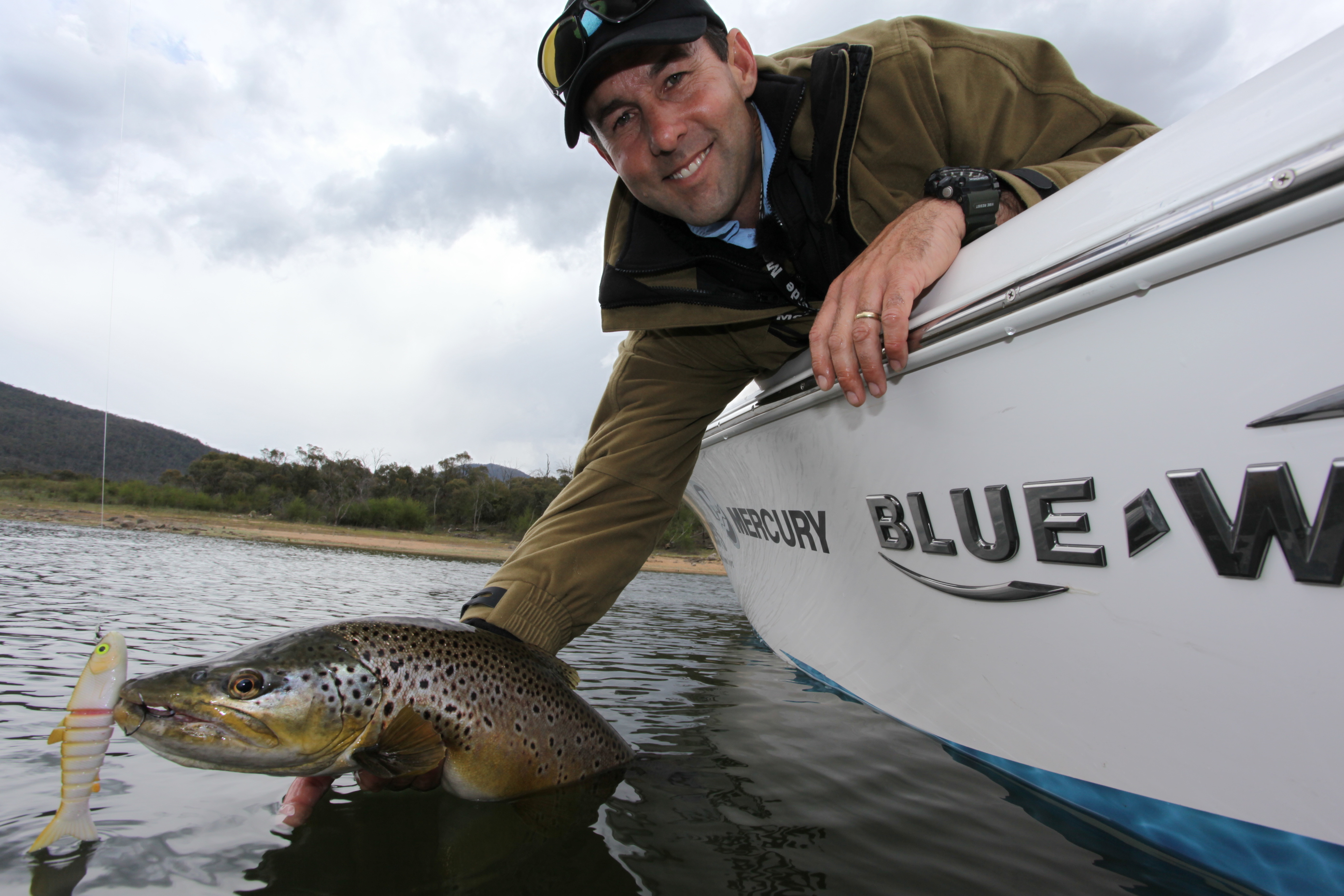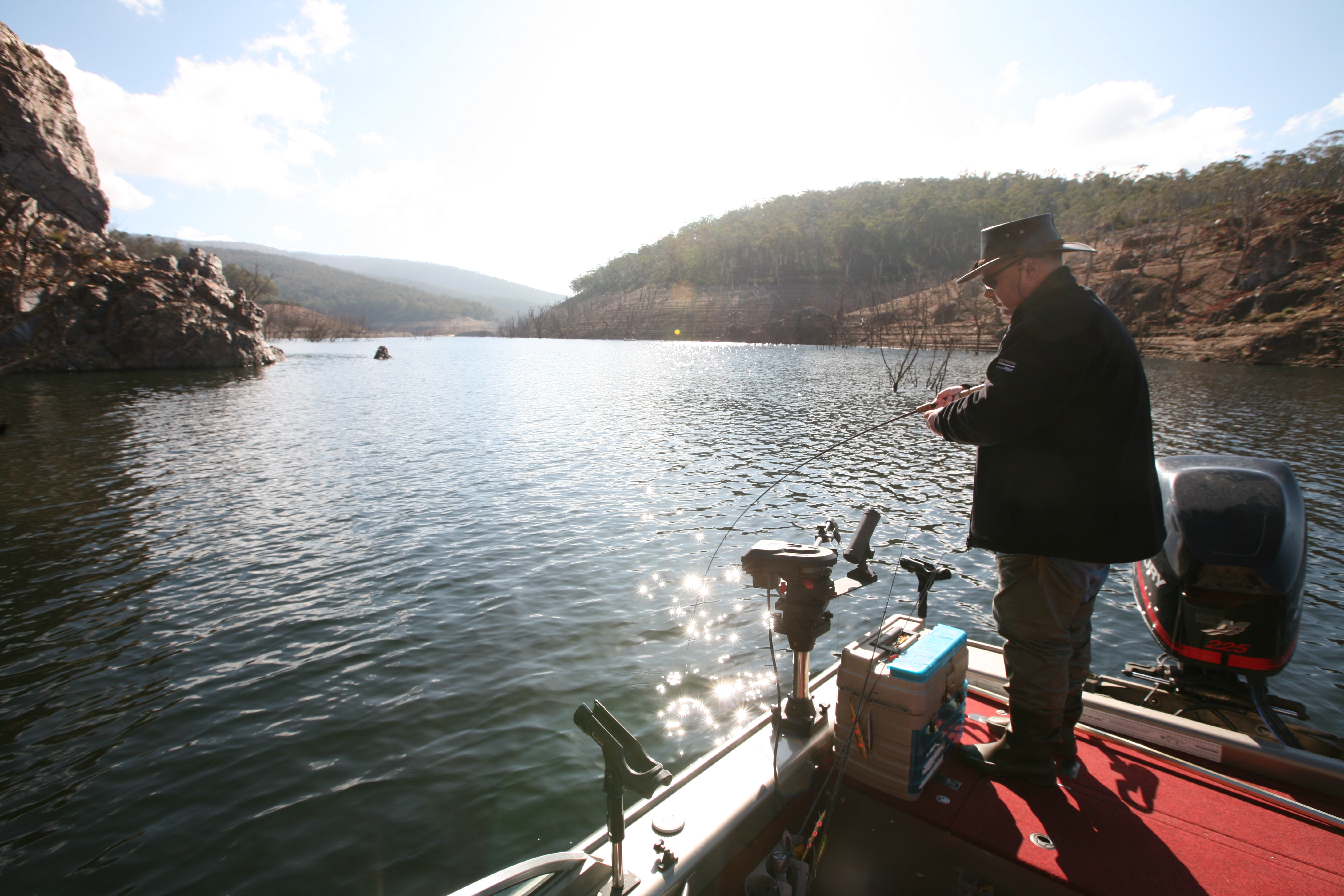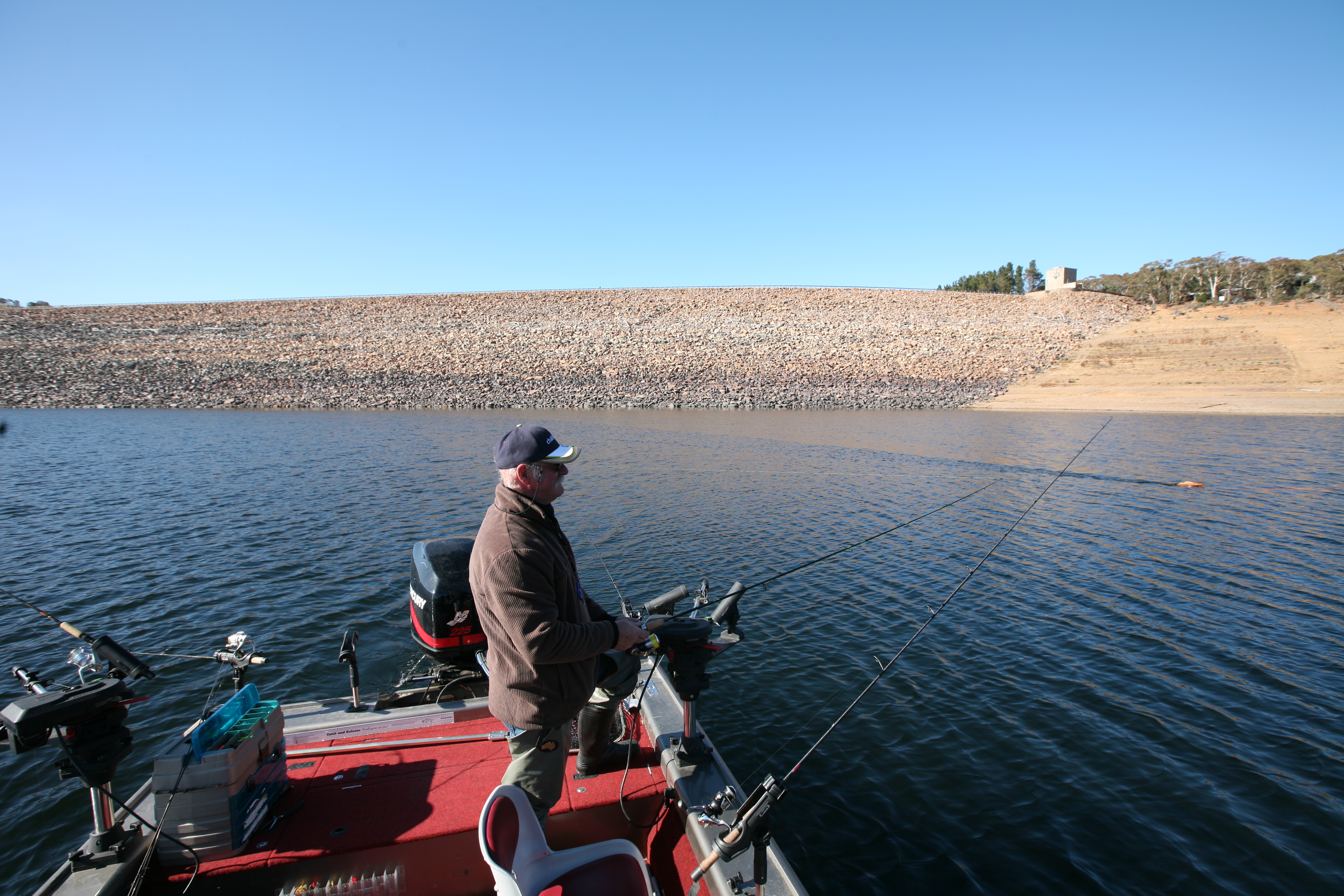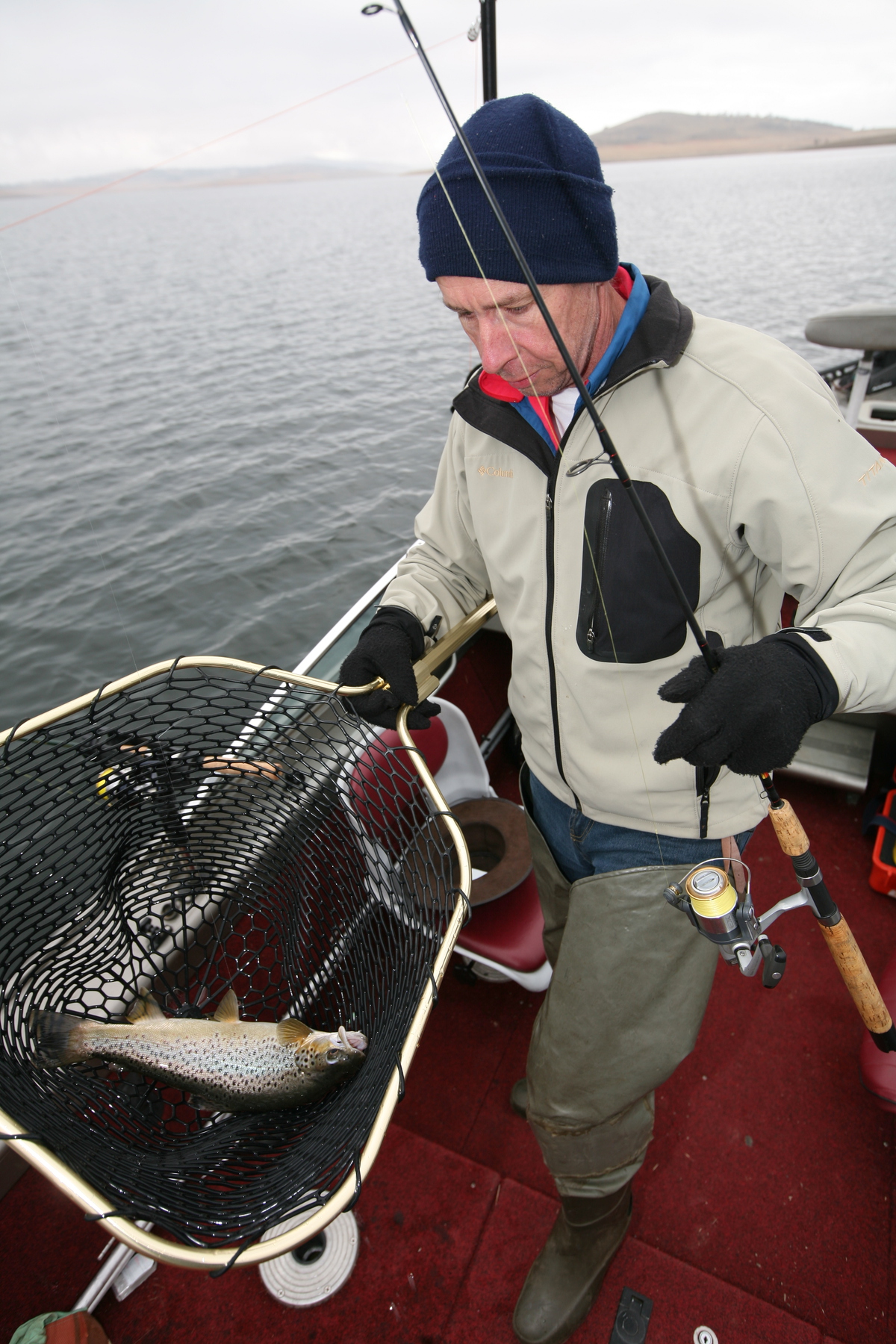Lake Eucumbene is the largest man-made waterway on mainland Australia. With no less than 224 km of shoreline to explore and a capacity of nearly nine times that of Sydney Harbour, you will need a lifetime to fully discover all the hidden secrets of this dominant trout fishery.Nestled high in the NSW alpine region (1200 m above sea level) Eucumbene forms an integral part of the Snowy Mountains Hydro-Electric Scheme.

Little Tolbar Inlet
Little Tolbar inlet is also known as Benefield Inlet and is situated north of the Braemar boat ramp. Located on the north-western shoreline, it is best fished from a boat and offers some excellent deep-water brown trout options through the latter part of spring into early summer. The deep water throughout this inlet and along the outer edges provides reliable trout fishing as the shallower margins of the lake begin to increase beyond the comfort levels of trout. Trolling a combination of lead core and flatline outfits will deliver the best catch rates.
Downrigging can be advantageous in the area; however, this method comes into its own during the three months after Christmas. Winged lures loaded onto the lead core outfits and fished with three to four colours out, has proven itself over the past couple of seasons. The reason I use winged lures is the fact they are not only highly effective and can be trolled quite quickly, resulting in aggression bites from quality browns, but the area is littered with submerged timber, so snags and lost lures are a common occurrence here. The other reason I opt for winged lures is based around the method I like to apply when trolling.

Every 20 or so metres completely cut the power of the electric motor for two seconds, so that the forward momentum of the boat slows. As the motor is shifted to the off position the side-to-side swaying action of the winged lure will slow significantly; replicating a swimming fish. However, because the boat is still moving, the lure will continue to swim from inertia but at a reduced speed and at the same time drop down the water column. It has been proven numerous times with under water cameras that trout will follow trolled lures for amazingly long periods of time, so it always pays to alter your trolling speed by both increasing and decreasing the speed to tempt a strike.
The other tip here that has been used in New Zealand’s big lakes for decades is to attach a large wet fly to the bottom hook of your lure. Using a 400 to 600 mm leader line, the action of the lure will impart movement to your large wet where quality fish often nail the trailing fly. Remember to use a slightly lighter breaking strain line for the leader from lure to fly so as to only lose the fly should it become snagged.
One disadvantage with this rig configuration is if a trout hooks up to your lure then you need to be wary that a loose swinging fly will be hanging underneath the fighting fish. In deep water this is generally not a huge issue, however if you intend to use the same rig across shallow water, attempt to keep the fish’s head up and away from the bottom or any obstacles such as twigs, grass tussocks and submerged thistles. The best way to accomplish this is to use a high rod position and even extend your arms above your head to keep the fish high in the water column and as close as possible to the surface.
Braemar Bay
The Braemar Bay Caravan Park is situated in the southern end of this popular bay. The Park has launching facilities and there is excellent fly, lure, and bait fishing within a short walking distance from the park. It is a favourite land-based area to fish the expanse of shoreline that runs all along the eastern edge of the bay. When the lake is full the first few hundred metres can be slow going through thick forest of eucalypts and a steep gradient bank. However, the lake hasn’t been full for many years, making the walk much more comfortable, although you will still need to traverse the steep bank. It is best to walk cautiously; take small steps and ensure you are on solid ground before transferring your weight. I have had a few mates roll ankles over the years, which has put a premature end to our weekends away.
Heading north all the way towards Cape Teviot is just less than two kilometres of mixed features made up of rocks, several minor bays and across mud and clay banks. Browns and rainbows are both caught here in good numbers through late spring with the best fishing occurring early morning on lures and late evening for those opting for the fly rod. The length of the shoreline is perfect for a morning or evening session working the edges.
If you are boat fishing, there are several productive and popular trolling lines both inside the bay and heading east into the entrance of Coppermine Bay. Hugging the western shoreline of the bay is also an excellent trolling area with flatlining methods the most productive. Attempt to stay in water less than three metres deep; however, keep an eye out for shallow boulders and mounds that will make a mess of your prop and hull. The stretch fishes well during strong south westerly winds and the added bonus is that it is well protected and safe to boat fish in.
Opposite Braemar Head in the north-west of the bay is Lamella Island, which has been connected to the mainland for over a decade now, due to low stable water levels. Lure casting from the boat, casting towards the shore, is a successful way to nail some quality Snowy Mountain browns. Several clusters of partly submerged trees are often exposed just inside the point which attracts trout through the warmer months. If you approach the trees under stealth using an electric motor and keep hull noise to a minimum, you will often see browns in excess of 50 cm sunning themselves near the shadows of the trees. Using weighted lure presentations on clear days and through the middle portions of the day will give you the best chance to hook into a trout or two. Naturally coloured metal vibes, jigheads in the 2 to 5 g mark, loaded with fish profile bodies, and even the old faithful metal wobblers will work.
Coppermine Bay
Coppermine Bay is best reached by boat departing Braemar Bay heading east. In calm conditions it’s about a 15-minute run from the boat ramp. The bay is a popular and well-known fly fishing bay thanks to the large weed beds that materialise as the water and weather warm. Night fishing through summer can be spectacular when the mudeyes are hatching. As well as fly fishing, try casting large floating minnows in summer. Slow rolling these hardbodies just under the surface will give you a chance at a trophy brown, particularly on clear nights with some moon light available.
Bait fishing from the shore using live mudeyes under a bubble float is also a highly effective way to bag some nice rainbows. At times these fish can be in good numbers and result in multiple fish landed in a single session. Pay attention to the weather as many boat anglers have been caught out when the wind shifts to the west and are faced with white cap covered open water for the trip back to Braemar. It is also worth noting that although Coppermine is a large bay, it is susceptible to strong winds from the north.

Wanadella Inlet and Eucumbene Cove
The dam wall end of Eucumbene has very deep water and is best fished using deep-water techniques. Downrigging will allow you to cover plenty of water while keeping an eye on your sounder for schooling rainbows. If your boat is not set up for downrigging, then leadcore trolling adjacent to steep banks can produce some good captures. Use a mix of hardbody minnows in trout patterns for best results. These trout patterned lures have been a mainstay for fishing Australian trout-filled lakes since minnows were first used in the late 1950s. Some of the new and old, highly tuned hardbodies have a tight shimmy action that most carnivorous trout can’t resist.
When selecting trout patterned hardbodies to troll, I always like to use three slightly different styles. With each lure transmitting a distinctive vibration in the water, due to the marginally different bib design, shape, and size, it is not uncommon to find just one lure style attracting all the interest from fish. Once you have discovered a pattern for the day, change your other lures to the same one which has been delivering the results to improve your chances of multiple hook-ups while trolling.
Lure casting towards the shoreline throughout Wandella Inlet and the standing timber adjacent to Wallaby Point is also worth persisting with if trolling is not your preferred method. Deep water casting can take patience and persistence, but the rewards of big brown trout make all the casts worth it. Remember to cover all depths of the water column, not just retrieving lures that hug the bottom contours. At times trout will suspend mid-water and pounce on a lure worked within their strike zone.
Try using micro soft plastics such as nymphs, shrimps, and crab patterns between 3 and 5 cm long. Dark colours such as olive, light green and brown have all helped us bag fish over the last three seasons. This same area is also a reliable location to bait fish with mudeyes through summer and into the first month of autumn. The best fishing occurs around the first mudeye hatch of the season when trout will gorge themselves on this protein-laden delicacy. Getting the exact timing of this right is generally more luck than good management as seasonal variances will affect these early hatches.
There you have a broad snapshot of the southwestern corner around the dam wall and Braemar. Next issue we will shift our focus across to the eastern slice of the lake, which will cover Buckenderra, Frying Pan and Middlingbank.

White Rocks and Seven Gates
White Rocks Inlet is a hugely popular spot with land-based anglers, as there is ample bays, banks, and points to chose from. The area has suffered for years with illegal camping on the foreshores and litter. Numerous times I have visited and been disgusted by the volume of litter left by some anglers. Generally, these are the small minority of anglers but if it continues then it won’t be long before access to shoreline via tracks will be completely cut off by landowners and the Snowy Hydro authorities.
To get to this area take the Seven Gates Road (unsealed track) off the Snowy Mountain Highway where you will go over numerous cattle grids to reach the lake. You will see multiple tracks down towards the water where you can select the area that best suits what sort of fishing you intend to undertake. Many fishers simply find a small area and set up their bait lines. This is a good way to land some fish but if you are like me and enjoy the challenge of casting lures around the lakes margins then remaining mobile is a better option.
Rather than restricting yourself to one small area you can prospect the edges with a variety of lures for many hours. A small backpack or bum bags with a selection of 15 to 20 lures, a spool of leader line, a pair of braid scissors, and pliers and you have sufficient terminal tackle to fish an entire day along the bank of White Rock Inlet. Through the early 80s and into the 1990’s trout pattern minnows and metal wobblers were the main stay for land-based lure casting. The metal wobblers were the lure of choice when the wind was moderate to strong as the weight of these lures allowed you to punch casting into the teeth of the wind while still obtaining a reasonable distance.
If you had the wind coming at you from the side or behind you then the light weight, hard bodied minnows were quickly connected your leader. These same lure selections will still produce fish however metal wobblers have been replaced with weighted soft plastics, yet hard bodied minnows continue to account for quality trout every season. If soft plastics are not your style, then try casting and retrieving Tassie Devils or similar winged type lures. Tassie’s have plenty of weight and are aerodynamic, making them a good selection option when the wind gets up. The other benefit is that anglers can make long casts with this genre of lures, meaning that your presentation is in the water longer, increasing your chances of landing a fish. When fishing very shallow water ensure you use a slightly faster than standard retrieval speed to safeguard against snags and your lure collecting weed. If you lure is still grubbing along the bottom then alter your rod position during the retrieve by moving your rod tip up to eye level, which will force your Tassie to pulse tantalisingly just under the surface.
Buckenderra
Directly east of the Caravan Park on the other side of the lake there are several small bays. The water in and around these bays and the points that separate them are very shallow. This does not stop the fish entering the areas to feed on mudeyes in summer, and worms and grubs in the cooler months. The best approach, to avoid stirring up the bottom and spooking fish, is to park your boat on one of the deeper points and walk around to the bank you want to fish.
On calm summer evenings it is not uncommon to see the bays awash with fish slurping terrestrials from the surface. Fly fishing at these times can be almost an inquiry a cast or nothing. The trout will become highly fixated on a single specific food item, so it pays to match the hatch. Mudeye fishing can also be of the highest quality here and many fishers will bag out in a short time period. If you are able to obtain the longer, slender bodied Couta mudeyes then be prepared for some hot action. There have been countless sessions over the years where we have had a selection of bait rods out and the trout has point blank refused the spider or bug mudeyes, yet every Couta has been scoffed.
The Buckenderra Arm from the caravan park up to Wainui Bay in the north is a productive trolling area, particularly when concentrating around the wind lanes. Early to Mid morning when the first puffs of wind begin to occur is the best time to target the wind lanes. Rainbows are the predominant species and will gladly take a trolled winged lure. Red and black stripes, orange herringbone, all pink, and the ever-reliable traffic light patterns are proven performers. If after several extended trolling runs with the winged lures you haven’t tasted any success, then it is worth changing to a spread of diving minnows. A shallow running trout pattern Rapala on one line and a deep diving hard body on the other.
Start with a bright coloured diver, particularly if the skies are clear. If the Rapala begins to generate some action then swap the bright diver to a natural colour such as green, red, or brown. Pre-dawn trolling tight against the edges along this stretch is also worth trying if the forecast is for a clear day ahead. If trolling across shallow water, ensure you keep boat noise to a minimum and position your trolled lures around 40 metres behind the boat so not to disturb as fish as you drive across them.
Rushy Plain and Brookwood bays
Rushy’s Bay is a popular area with mudeye anglers through the warmer months of the year and often you will find the shoreline sprinkled with cars of anglers hoping to experience one of those hot sessions that Eucumebene is renowned for. The bay is equally popular with fly fishers and football sized rainbows caught here both when fish are rising to dries, and the multitude of sub-surface options. Dredging the bottom with large natural-coloured wets is nowhere near as exhilarating as a gentle slurp from a rising fish, however, it is a highly effective method during low light condition and through the night. Still, balmy evenings can produce some monster browns who will come into feed across the shallow margins when the water temperature cool.
Day light fishing should be concentrated around the drop off areas where points and mud spits fall into two to three metres. Fish will patrol these areas either searching for food or moving around the lake in pursuit of more favored water conditions. Slowly moving along these areas while keeping an eye on your sounder is an ideal way to pinpoint some quality drop zones.
Providing the bottom is made of a mix of mud and scattered gravel in that three-metre depth zone, I will work give the water a thorough working over with a mix of soft plastics, metal vibes, and deep diving minnows. I always work the bottom layer of the water column first opting for sinking presentations. Wrigglers and paddle tails are reliable starting plastics. If you have marked fish lying on the bottom yet you cannot generate any interest, switch to a stick bait or straight minnow body style. Split tails or the like will do the trick. The key is to select a lure that has next to no action when retrieved or paused. Employ a slow retrieve while implementing fluent small lifts. Keep your lure close to the bottom and remember to maintain a fluent lift every time. Any jerky or violent flicks or lifts with a stick bait plastics will only spook fish.
Along the southwestern shoreline of Rushy’s there are several small rocky points that are productive land-based spots to baitfish and lure cast. During summer and autumn, mudeyes fished under bubble floats are dynamite. Towards the latter part of autumn right through winter and in early spring bardi grubs can be the only bait that will get bites. Trout will get fixated on these protein rich grubs and fish will regularly ignore scrub worms and all other offering yet bite unreservedly on grubs.

Anglers Reach
Trolling at Anglers Reach has been part of the fabric of trophy trout in Eucumbene for a long while. There are literally hundreds of metres of trolling runs along the rubbly shallow banks, deep points, timber lined bays and expansive inlets. Long drop back flat line trolling works well on calm days in water depths from 2 to 4 metres. If there are wind lanes then zig zag them in search for rainbow trout. On windy days concentrate all your efforts around deep points and rocky shorelines.
The Providence Narrows is just north of Anglers Reach and features extensive yabby beds. From Studlands Point running south to Beacon Point there is almost eight kilometers of yabbie beds.
Providence Portal
An attractive feature of this most northern arm of lake Eucumbene are the number of land-based locations to fish. Lure casting with Rapala minnows will entice any predatory brown trout in the area. The northern portion of Providence Flats is very productive lure and bait water.
Hot tip:
There is an excellent waterproof Fishing map on Lake Eucumbene available from AFN Map 9 Lake Eucumbene and Lake Jindabyne.

